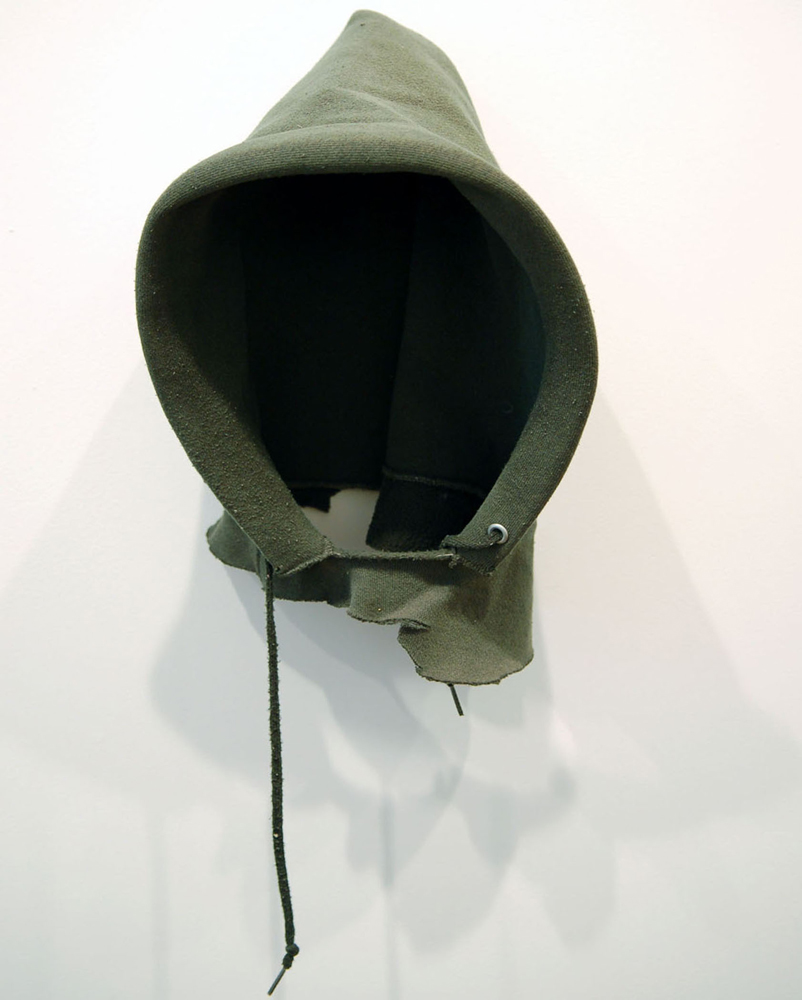Jenny Tang
The poor are not dirty, but sacred. Did Arte Povera know anything of poverty? Do museums ever create safe harbor for those without home, who must make place out of nowhere? We have all survived under unlikely circumstances. Crossing oceans whose water could not satiate, the enslaved were shipped across borders as cargo. But we carry our own borders with us even as we cross others, and David Hammons’s art still professes an abstract truth, a blue truth and a truth to the blues: that those who chose to journey, and those who chose because choiceless, shall inherit this earth.
Plate 15 David Hammons (American, born 1943). Untitled (Night Train). 1989. Glass, silicone glue, and coal, 42 x 42 x 30" (106.7 x 106.7 x 76.2 cm), width and depth variable. Gift of the Hudgins Family in memory of Lawrence D. "Butch" Morris. 53.2013
The bottles of Night Train Express and Thunderbird that comprise the circle at the center of Night Train are not clean but dirty. The grit at the bottom of these bottles is the material remainder of the black lips that have touched them, the only trace of a touch that leaves no trace. In this way, the bottles might not be clean, but they are pure, for they have been purified by the lips that sipped, guzzled, and grasped at the open to satiate their thirst. Hammons takes as his material the discarded bottles of a thirst created not by poverty but the inadequacy of voice to lend expression to a need that has never been answered. In its unrelenting intimacy with coal and cheap, fortified wine, Night Train attests to the poetic beauty of the base and the cheap, to the things that we burn and the things that might burn us if we let them. As Robert Farris Thompson writes, Hammons “knows all the places where the winos hide, in shame, their bottles, under mail boxes, inside streetlamps, within cracks between the buildings.” By exposing the bottles hidden out of shame even when discarded, “Hammons at once exalts traces of the spirit and arrests the seal and substance of addiction.” Night Train goes nowhere but might lead us somewhere.
The first iteration of Night Train, exhibited at P.S.1 in 1990 at Hammons's Rousing the Rubble retrospective, did not include the coal now gathered at its base. Coal was reserved instead for Kick the Bucket, made the previous year with the same bottles arranged in circular form, but with a bucket as a keystone. The bucket marked the highest point of an arc that, as Thompson puts it, “maps points along an alcoholic’s life, contrasting pleasure to finality." Installed against the wall at P.S.1, Kick the Bucket resembled a cairn, an archaic grave marker, but turned the colloquialism kick the bucket (die with a resonant finality) into a solicitation by placing the bucket at its apex. No gravestone, then, but a higher goal to aim for. Installed nearby on the gallery floor, Night Train resembled Kick the Bucket’s unencumbered döppelganger, standing still but capable of rollicking forward at any moment.
Now with coal at its base, Night Train is no less mobile but has become a portal, suggesting that the grave need not be a final destination. In a world that has left behind the discontented and the dispossessed, Hammons still takes them with him wherever he goes, rendering burden into poetry. The disjunctive spiral of bottles gives way to the rhythm of color, transparent and green glass modulated to echo in visual form the call of passing trains, telling you that time may be measured yet can form by new measures. The Polish poet Wisława Szymborska once suggested that we are divisible into material flesh and transcendent poetry. Hammons is that rare artist capable of refusing this division, harnessing the poetic force of the material like a medieval alchemist determined to turn base metal into gold. Like an alchemist, Hammons regards matter as essentially transformative, catalyzing change and being changed in the process. As he once put it to Robert Sill, “I am going to make stuff with these new materials that doesn't necessarily have to do with my culture. But it will anyway, just because I made it."
According to Sill, the public swimming pools in Hammons’s hometown of Springfield, Illinois were off-limits to African-Americans. Consequently he never learned to swim, but since moving to New York in 1975, he has learned to dive and to dig in order to live. Robert Rauschenberg did the same, exalting transgression by dragging the street to his canvases. In breaking the art’s code, Rauschenberg remade it after his own image in his Combines. Hammons, having long ago lost faith in transgression, is happy to be a trespasser. In response to Sill’s observation in 1994 that he always seemed to be able to stay one step ahead of the art world, Hammons said: “There are still so many cracks. I've got it figured out. They [the art world] don't know, can't figure out what I'm doing because they don't have anything to measure it with.” With Night Train, we are in a world out of measure, thirty seconds off an inch, a circle that is an incomplete embrace and therefore, perhaps, beyond measure.
Research for this essay was generously supported by the Museum Research Consortium, funded by The Andrew W. Mellon Foundation, at The Museum of Modern Art, NY.
Jenny Tang is a historian of modern and contemporary art and visual culture and an independent curator. Her research centers on race, subjectivity, and aesthetics. She is a joint PhD candidate in History of Art and Film & Media Studies at Yale University, where she is completing her dissertation on carceral logics of visuality in mid-twentieth century Atlantic modernism.





